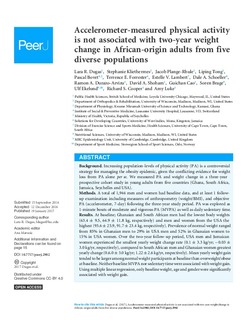Accelerometer-measured physical activity is not associated with two-year weight change in African-origin adults from five diverse populations
| dc.contributor.author | Dugas, Lara R. | |
| dc.contributor.author | Kliethermes, Stephanie | |
| dc.contributor.author | Plange-Rhule, Jacob | |
| dc.contributor.author | Tong, Liping | |
| dc.contributor.author | Bovet, Pascal | |
| dc.contributor.author | Forrester, Terrence E. | |
| dc.contributor.author | Lambert, Estelle V. | |
| dc.contributor.author | Schoeller, Dale A. | |
| dc.contributor.author | Durazo-Arvizu, Ramon A. | |
| dc.contributor.author | Shoham, David A. | |
| dc.contributor.author | Cao, Guichan | |
| dc.contributor.author | Brage, Søren | |
| dc.contributor.author | Ekelund, Ulf | |
| dc.contributor.author | Cooper, Richard S. | |
| dc.contributor.author | Luke, Amy | |
| dc.date.accessioned | 2018-01-31T09:29:31Z | |
| dc.date.available | 2018-01-31T09:29:31Z | |
| dc.date.issued | 2017-01-19 | |
| dc.identifier.citation | PeerJ. 2017, 5, e2902 | nb_NO |
| dc.identifier.uri | http://hdl.handle.net/11250/2480869 | |
| dc.description | Distributed under Creative Commons CC-BY 4.0 (https://creativecommons.org/licenses/by/4.0/) | nb_NO |
| dc.description.abstract | Background. Increasing population-levels of physical activity (PA) is a controversial strategy for managing the obesity epidemic, given the conflicting evidence for weight loss from PA alone per se. We measured PA and weight change in a three-year prospective cohort study in young adults from five countries (Ghana, South Africa, Jamaica, Seychelles and USA). Methods. A total of 1,944 men and women had baseline data, and at least 1 followup examination including measures of anthropometry (weight/BMI), and objective PA (accelerometer, 7-day) following the three-year study period. PA was explored as 1-minute bouts of moderate and vigorous PA (MVPA) as well as daily sedentary time. Results. At baseline; Ghanaian and South African men had the lowest body weights (63.4 ± 9.5, 64.9 ± 11.8 kg, respectively) and men and women from the USA the highest (93.6 ± 25.9, 91.7 ± 23.4 kg, respectively). Prevalence of normal weight ranged from 85% in Ghanaian men to 29% in USA men and 52% in Ghanaian women to 15% in USA women. Over the two-year follow-up period, USA men and Jamaican women experienced the smallest yearly weight change rate (0.1 ± 3.3 kg/yr; −0.03 ± 3.0 kg/yr, respectively), compared to South African men and Ghanaian women greatest yearly change (0.6.0 ± 3.0 kg/yr; 1.22 ± 2.6 kg/yr, respectively). Mean yearly weight gain tended to be larger among normal weight participants at baseline than overweight/obese at baseline. Neither baseline MVPA nor sedentary time were associated with weight gain. Using multiple linear regression, only baseline weight, age and gender were significantly associated with weight gain. | nb_NO |
| dc.language.iso | eng | nb_NO |
| dc.publisher | PeerJ | nb_NO |
| dc.subject | obesity | nb_NO |
| dc.subject | weight gain | nb_NO |
| dc.subject | physical activity | nb_NO |
| dc.title | Accelerometer-measured physical activity is not associated with two-year weight change in African-origin adults from five diverse populations | nb_NO |
| dc.type | Journal article | nb_NO |
| dc.type | Peer reviewed | nb_NO |
| dc.description.version | publishedVersion | nb_NO |
| dc.rights.holder | Copyright 2017 Dugas et al | nb_NO |
| dc.source.journal | PeerJ | nb_NO |
| dc.identifier.doi | 10.7717/peerj.2902 | |
| dc.description.localcode | Seksjon for idrettsmedisinske fag / Department of Sport Medicine | nb_NO |
Tilhørende fil(er)
Denne innførselen finnes i følgende samling(er)
-
Artikler / Articles [2119]
